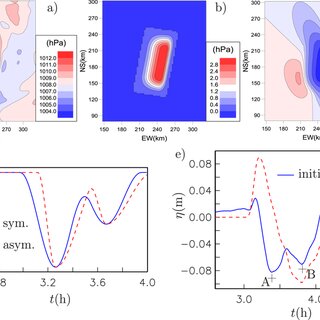January 2022
·
48 Reads
·
1 Citation
Free wave generation due to a ship or storm moving past a shallow, great depth change of the water, is measured on the shore (coast), modeled and compared. The free waves are generated at the depth change where the forced wave and velocity field attached to the moving pressure system adjust to the new depth. The wavenumber is a factor 1/12 smaller in the meteotsunami case compared to the ship case. The subcritical depth Froude numbers are similar in the two cases. The meteotsunami that occurred on the Norwegian Coast on 29–30 June 2019 was driven by a supercell thunderstorm moving at speed 110 km/hr. A localized, strong high pressure feature of width of 60 km and crest of 120 km obtained from weather forecast was used as input for a set of simulations of the water‐level response including realistic bathymetry. At the transition between the North Sea and the Norwegian Trench, the storm generated a free depression wave. This arrived at the coast 24 min ahead of the depression attached to the storm. The calculation fits to a period of 23 min, of a series several oscillations of height of 0.3–0.4 m, as measured by the water‐level gauge. An impulsive start‐up generates an additional forerunning elevation wave. Short waves of period of 1/3 of the main ship‐driven waves may originate from the steep gradients of the bow and stern. Similarly, short waves of period 6–7.5 min (0.002–0.003 Hz) are observed in the measured water‐level on the coast.











![Topo-bathymetric map of the Sunda Strait including the southern coasts of the Sumatra Island and western coasts of the Java Island. The interval of isobaths is 100m\documentclass[12pt]{minimal} \usepackage{amsmath} \usepackage{wasysym} \usepackage{amsfonts} \usepackage{amssymb} \usepackage{amsbsy} \usepackage{mathrsfs} \usepackage{upgreek} \setlength{\oddsidemargin}{-69pt} \begin{document}$$100\,\mathrm {m}$$\end{document} below a water depth of 100m\documentclass[12pt]{minimal} \usepackage{amsmath} \usepackage{wasysym} \usepackage{amsfonts} \usepackage{amssymb} \usepackage{amsbsy} \usepackage{mathrsfs} \usepackage{upgreek} \setlength{\oddsidemargin}{-69pt} \begin{document}$$100\,\mathrm {m}$$\end{document} and 25m\documentclass[12pt]{minimal} \usepackage{amsmath} \usepackage{wasysym} \usepackage{amsfonts} \usepackage{amssymb} \usepackage{amsbsy} \usepackage{mathrsfs} \usepackage{upgreek} \setlength{\oddsidemargin}{-69pt} \begin{document}$$25\,\mathrm {m}$$\end{document} in shallower regions. The light blue labelled markers indicate the locations of the four tidal observation gauge stations and the green marker the location of the observation of the maximum runup height (13.5m\documentclass[12pt]{minimal} \usepackage{amsmath} \usepackage{wasysym} \usepackage{amsfonts} \usepackage{amssymb} \usepackage{amsbsy} \usepackage{mathrsfs} \usepackage{upgreek} \setlength{\oddsidemargin}{-69pt} \begin{document}$$13.5\,\mathrm {m}$$\end{document}). The two reddish markers indicate the locations where dispersion and tsunami model tests are evaluated. The green rectangle in the middle of the map surrounds the Krakatoa complex, which is shown in more detail in Fig. 2. Two red rectangles at the coast of the Java Island define the regions for the inundation study. The violet zone extends over the region where the seafloor is deepened to give a minimum depth of 60m\documentclass[12pt]{minimal} \usepackage{amsmath} \usepackage{wasysym} \usepackage{amsfonts} \usepackage{amssymb} \usepackage{amsbsy} \usepackage{mathrsfs} \usepackage{upgreek} \setlength{\oddsidemargin}{-69pt} \begin{document}$$60\,\mathrm {m}$$\end{document}](https://www.researchgate.net/publication/341060556/figure/fig4/AS:960000503599116@1605893364259/Topo-bathymetric-map-of-the-Sunda-Strait-including-the-southern-coasts-of-the-Sumatra_Q320.jpg)




![Figure 2. The asymptotic wave front, in a depth of d D 5000 m, after 1 h and 15 min corresponding to a propagation distance of 1000 km. The results for the quadratic pressure profile and full potential theory are drawn by an orange line, while the one for the linear pressure profile is represented by a red one. [Colour figure can be viewed at wileyonlinelibrary.com]](https://www.researchgate.net/profile/Stefan-Vater-3/publication/312284432/figure/fig1/AS:461704573263872@1487090356319/The-asymptotic-wave-front-in-a-depth-of-d-D-5000-m-after-1-h-and-15-min-corresponding_Q320.jpg)


![Figure 5. Comparison of the analytical (black) sea surface height of the solitary wave with the simulation results of the quadratic (yellow) and linear (blue) initial vertical profile and those obtained after a propagation time of 10, 20, and 30 s to the right. [Colour figure can be viewed at wileyonlinelibrary.com]](https://www.researchgate.net/profile/Stefan-Vater-3/publication/312284432/figure/fig2/AS:461704573263873@1487090356333/Comparison-of-the-analytical-black-sea-surface-height-of-the-solitary-wave-with-the_Q320.jpg)










